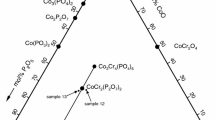Abstract
Studies on the kinetics and mechanism of the reaction leading to Cr2(MoO4)3 have been made using X-ray diffraction and infrared spectroscopy. The apparent activation energy, E=285±22 kJ/mol has been calculated, based on the Ginstling-Brounstein diffusion controlled model.
Similar content being viewed by others
References
L.M. Plyasova, L.M. Kefeli:Izv. AN SSSR, Neorg. Mater.,3, 906 (1967).
A.W. Sleight, L.H. Brixner:J. Solid State Chem.,7, 172 (1973).
J. Walczak, M. Kurzawa, E. Filipek:Thermochim. Acta,150, 133 (1989).
J. Beretka, T. Brown:J. Am. Ceram. Soc.,66, 383 (1983).
A.M. Ginstling, B.I. Brounstein:Zh. Prikl. Khim.,21, 887 (1948).
K. Eda:J. Solid State Chem.,95, 64 (1991).
G.M. Clark, W.P. Doyle:Spectrochim. Acta,22, 1441 (1966).
C.J. Serna, J.L. Rendon, J.E. Iglecias:Spectrochim. Acta,38 A, 797 (1982).
Author information
Authors and Affiliations
Rights and permissions
About this article
Cite this article
Tabero, P. Synthesis of Cr2(MoO4)3 . React Kinet Catal Lett 67, 137–141 (1999). https://doi.org/10.1007/BF02475839
Received:
Accepted:
Issue Date:
DOI: https://doi.org/10.1007/BF02475839




